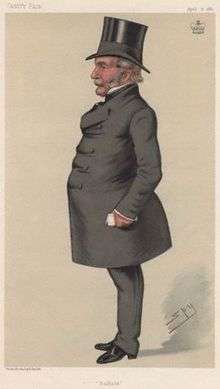Robert Adair, 1st Baron Waveney
Robert Alexander Shafto Adair, 1st Baron Waveney (25 August 1811 – 15 February 1886)[1] was a British Liberal Party politician who served as a Member of Parliament (MP) for Cambridge for 8 of the years from 1847 to 1857.

Lord Waveney as caricatured by Spy (Leslie Ward) in Vanity Fair, April 1881
Born in Ballymena, County Antrim, Ireland,[2] he was the older of the two sons of Sir Robert Shafto Adair, 1st Baronet, and his first wife Elizabeth Maria Strode.[3] He married Theodosia Meade in 1836; they had no children.[4]
Adair first stood for election to Parliament in April 1843, when he was the runner-up at a by-election for the Eastern division of Suffolk.[5] He was unsuccessful again at a by-election for the borough of Cambridge in July 1845,[6] but at the 1847 general election he was elected as one of Cambridge's two MPs.[6] He was defeated at the 1852 general election, but that result was overturned on petition and he was returned to the House of Commons at the resulting by-election in August 1854. He was unseated again in 1857 general election, and, at the 1859 general election, again unsuccessfully contested East Suffolk.[6] He stood again one more time, in Canterbury at the 1865 general election, but did not win a seat.[7] He was appointed High Sheriff of Antrim in 1853.[8]
A Fellow of the Royal Society,[2] he succeeded to the baronetcy in 1869, on the death of his father.[1] He was ennobled on 10 April 1873, as Baron Waveney, of South Elmham in the County of Suffolk.[9][10] He was Provincial Grand Master of the United Grand Lodge of England Masonic province of Suffolk at the time of his death.[11] He served as Lord Lieutenant of Antrim from 1884 until his death in 1886,[10][12] aged 74, when the peerage became extinct and he was succeeded in the baronetcy by his younger brother Hugh (1815–1902), who had been MP for Ipswich from 1847 to 1874.
Ballymena
The Adair family owned extensive estates in Ballymena, and have been described as the "founding fathers" of the town.[13] The town is built on land given to the Adair family by King Charles 1 in 1626, on the provision that the town holds two annual fairs and a free Saturday market in perpetuity.[14]
In 1865 Adair began the construction in the demesne of Ballymena Castle, a substantial family residence in the Scottish baronial style.[15] The castle was not completed until 1887,[16] and was demolished in 1957 after having lain empty for some years and being vandalised; the site is now a car park. In 1870, Adair donated The People's Park to Ballymena, engaging fifty labourers to work for six months landscaping it.[17]
References
- "Baronetage: A, part 1". Leigh Rayment's House of Commons pages. Retrieved 12 January 2010.
- "Adair, Robert Alexander Shafto". Dictionary of Ulster Biography. Retrieved 12 January 2010.
- Lundy, Darryl. "Sir Robert Shafto Adair, 1st Bt". ThePeerage.com. Retrieved 12 January 2010.
- Lundy, Darryl. "Robert Alexander Shafto Adair, 1st and last Baron Waveney". ThePeerage.com. Retrieved 12 January 2010.
- Craig, F. W. S. (1989) [1977]. British parliamentary election results 1832–1885 (2nd ed.). Chichester: Parliamentary Research Services. p. 461. ISBN 0-900178-26-4.
- Craig, op. cit., pages 76–77
- Craig, op. cit., page 79
- "Fellows of the Royal Society who are or were Freemasons, listed alphabetically" (PDF). Archived from the original (PDF) on 2 December 2012. Retrieved 9 November 2012.
- "No. 23964". The London Gazette. 4 April 1873. p. 1822.
- "Peerages: W, part 1". Leigh Rayment's House of Commons pages. Retrieved 12 January 2010.
- "Freemasonry in Suffolk" (PDF). The Freemason's Chronicle. XXIII (No. 57, Saturday 10 April 1886): 225–226. 1886.
- "Fellows of the Royal Society who are or were Freemasons, listed alphabetically" (PDF). Archived from the original (PDF) on 2 December 2012. Retrieved 9 November 2012.
- "History". Ballymena Borough Council website. Archived from the original on 1 April 2010. Retrieved 13 January 2010.
- "Brief History of Ballymena". Ballee Baptist Church website. Archived from the original on 10 October 2008. Retrieved 13 January 2010.
- "Ballymena Historic Timeline". Ballymena Borough Council website. Archived from the original on 3 July 2010. Retrieved 13 January 2010.
- "History of the People's Park". Ballymena Borough Council website. Archived from the original on 20 November 2008. Retrieved 13 January 2010.
External links
- Hansard 1803–2005: contributions in Parliament by Sir Robert Adair
- Portraits of Robert Alexander Shafto Adair, Baron Waveney at the National Portrait Gallery, London

- Adair family archives, at the National Archives
| Parliament of the United Kingdom | ||
|---|---|---|
| Preceded by Hon. John Manners-Sutton Fitzroy Kelly |
Member of Parliament for Cambridge 1847 – 1852 With: Hon. William Campbell |
Succeeded by Kenneth Macaulay John Harvey Astell |
| Preceded by Kenneth Macaulay John Harvey Astell |
Member of Parliament for Cambridge 1854 – 1857 With: Francis Mowatt |
Succeeded by Kenneth Macaulay Andrew Steuart |
| Baronetage of the United Kingdom | ||
| Preceded by Robert Shafto Adair |
Baronet of Flixton Hall, Suffolk 1869–1886 |
Succeeded by Hugh Edward Adair |
| Peerage of the United Kingdom | ||
| New creation | Baron Waveney 1873–1886 |
Extinct |
| Honorary titles | ||
| Preceded by The Marquess of Donegall |
Lord Lieutenant of Antrim 1884–1886 |
Succeeded by Sir Edward Porter Cowan |